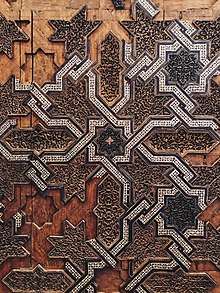Ali ibn Yusuf
Ali ibn Yusuf (also known as "Ali Ben Youssef") (Arabic: علي بن يوسف) (born 1084 died 26 January 1143[1]) was the 5th Almoravid emir. He reigned from 1106–1143.
| Ali ibn Yusuf | |||||
|---|---|---|---|---|---|
| Amir Al-Muslimin | |||||
_mint.jpg) Gold dinar minted by Ali ibn Yusuf | |||||
| Sultan of Morocco | |||||
| Reign | 1106–1143 | ||||
| Predecessor | Yusuf ibn Tashfin | ||||
| Successor | Tashfin ibn Ali | ||||
| Born | 1084 Ceuta | ||||
| Died | 26 January 1143 | ||||
| |||||
| Dynasty | Almoravid | ||||
| Father | Yusuf ibn Tashfin | ||||
| Religion | Islam | ||||
Biography
Ali ibn Yusef was born in 1084 in Ceuta. He was the son of Yusuf ibn Tashfin, the fourth Almoravid Emir, and a Christian concubine. At the time of his father's death, in September 1106, he was 23 years old. He succeeded his father on 2 September 1106.[2][3] Ali ruled from Morocco and appointed his brother Tamim ibn Yusuf as governor of Al-Andalus. Ali expanded his territories in the Iberian Peninsula by capturing Zaragoza in 1110 but eventually lost it again to Alfonso I, King of Aragon, in 1118. Cordoba rebelled against the Almoravids in 1121.
Patronage

_(cropped_and_retouched).jpg)
He commissioned a minbar now known as the Minbar of the Kutubiyya Mosque from a workshop in Córdoba to furnish his grand mosque, the original Ben Youssef Mosque (destroyed under the Almohads), in the imperial capital, Marrakesh.[5] The Almoravid Qubba also bears Ali's name.[4]
At the advice of Abu Walid Ibn Rushd (grandfather of Averroes), Ali built walls around Marrakesh as Ibn Tumart became more influential.[6][7] There had been walls around the mosque and the palace, but Ali ibn Yūsuf spent 70,000 gold dinars on the city's fortifications, doubling the city's size, and told the amirs of Al-Andalus to fortify their walls as well.[8]
He also established an irrigation system in Marrakesh, a project managed by Obeyd Allah ibn Younous al-Muhandes.[9] This irrigation system made use of qanawat (قناة, p. قنوات).[9] Ali also had the first bridge over the Tensift River built.[9]
In 1139, he lost the Battle of Ourique against the Portuguese forces led by the count Afonso Henriques, which allowed Afonso to proclaim himself an independent King.
Ali was succeeded by his son Tashfin ibn Ali in 1143.[11]
Sargasso Sea
According to the Muslim cartographer Muhammad al-Idrisi the Mugharrarin (also translated as "the adventurers") sent by Ali ibn Yusuf, led by his admiral Ahmad ibn Umar, better known under the name of Raqsh al-Auzz reached a part of the ocean covered by seaweed, identified by some as the Sargasso Sea,[12] which stretches into the Atlantic from Bermuda.
Family
Ali was the son of Yusuf ibn Tashfin. He had at least two sons:[11]
- Tashfin ibn Ali, governor of Granada and Almeria in 1129 and Cordoba in 1131.[13] Succeeded his father in 1143.
- Ishaq ibn Ali. Died in 1147.
References
- 7 rajab 537 AH
- Lévi-Provençal, E. (1986) [1960]. "ʿAlī b. Yūsuf b. Tās̲h̲ufīn". In Bearman, P.; Bianquis, Th.; Bosworth, C.E.; van Donzel, E.; Heinrichs, W.P. (eds.). Encyclopaedia of Islam. I (2nd ed.). Leiden, Netherlands: Brill Publishers. p. 389. ISBN 9004081143.
- Bennison, Amira K. (2016). The Almoravid and Almohad Empires. Edinburgh University Press. p. 54. ISBN 978-0-7486-4680-7.
- الإسبانية, دورية قنطرة. "حول القبة المرابطية في مراكش". المراكشية : بوابة مراكش (in Arabic). Retrieved 2020-05-19.
- Bloom, Jonathan; Toufiq, Ahmed; Carboni, Stefano; Soultanian, Jack; Wilmering, Antoine M.; Minor, Mark D.; Zawacki, Andrew; Hbibi, El Mostafa (1998). The Minbar from the Kutubiyya Mosque. The Metropolitan Museum of Art, New York; Ediciones El Viso, S.A., Madrid; Ministère des Affaires Culturelles, Royaume du Maroc. pp. 3–4.
- كتاب الحلل الموشية في ذكر الأخبار المراكشية (in Arabic). مطبعة التقدم،. 1811. p. 71.
- Deverdun, Gaston (1959). Marrakech: Des origines à 1912. Rabat: Éditions Techniques Nord-Africaines. pp. 108–109.
- "دولة الإسلام في الأندلس • الموقع الرسمي للمكتبة الشاملة". 2017-02-13. Archived from the original on 2017-02-13. Retrieved 2020-05-19.
- Viollet, Pierre-Louis (2017-10-02). Water Engineering inAncient Civilizations: 5,000 Years of History. CRC Press. ISBN 978-0-203-37531-0.
- IslamKotob. المسالك شرح موطا مالك لابن العربي - 2 (in Arabic). IslamKotob.
- SPAIN.htm Moorish Spain
- Fromherz, Allen James, ‘The Near West’, page 133, 2016, Edinburgh University Press. ISBN 9781474426404
- Extrait de la Chronique intitulée Kamel-Altevarykh par Ibn-Alatyr, RHC Historiens orientaux I, p. 413.
| Preceded by Yusuf ibn Tashfin |
Almoravids 1106–1143 |
Succeeded by Tashfin ibn Ali |